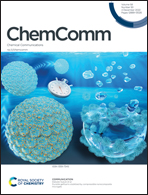Aliovalent anion substitution as a design concept for heteroanionic Ruddlesden–Popper hydrides†
Abstract
Substituting 2 O2− ⇒ N3− + H− in LiLa2HO3 yields dark-brown heteroanionic hydrides, which were synthesized by solid-state reactions from Li3N, LaH3 (and La2O3). They crystallize in the K2NiF4 type structure with mixed H/N sites in LiLa2N1.5H2.5 and with mixed N/O sites in LiLa2N0.84(6)H1.56(3)O1.16(6). The latter is a semiconductor with small band gap and partly covalent Li–H interaction.



 Please wait while we load your content...
Please wait while we load your content...